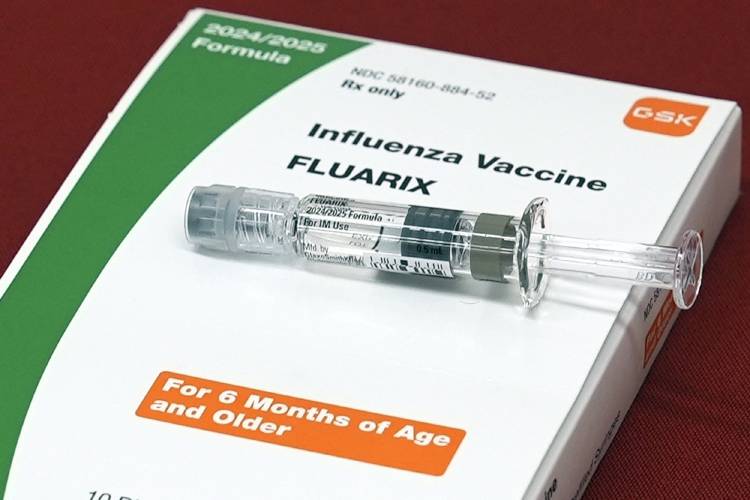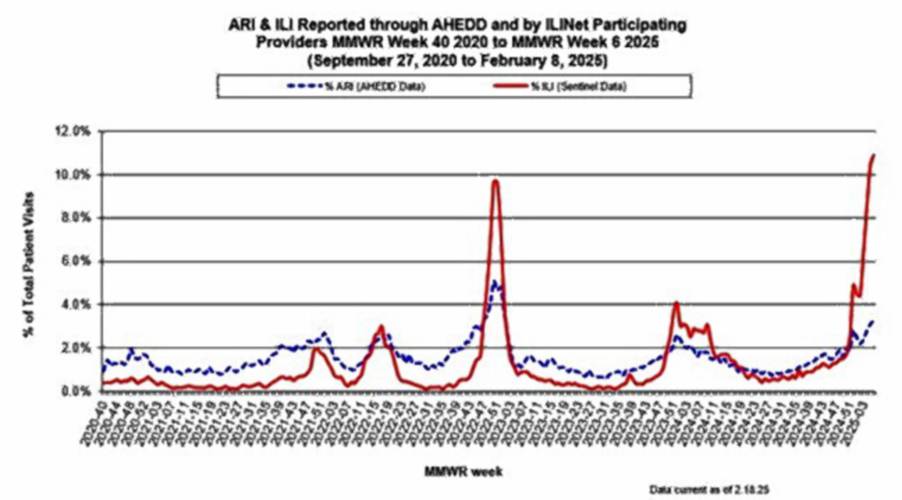Flu and other breathing illnesses keep rising in New Hampshire
| Published: 02-25-2025 3:01 PM |
By one measure, influenza is now more widespread in New Hampshire than during the huge flu spike at the end of 2022, part of the reason CDC says the state is seeing “very high” levels of all illnesses related to breathing.
New Hampshire Division of Public Health Services estimates the amount of flu in the state partly by looking at reports from doctors and hospitals of cases of “influenza-like illness” and more serious “acute respiratory illness.” As of the most recent report, covering the start of February, that first measure is now worse than it was in December 2022, with some 11% of patient visits caused by flu-like sickness, the highest rate in more than a decade. Acute illness is also rising, although not yet at 2022 levels.
“This is probably one of the most challenging and difficult flu seasons we’ve seen for many, many years,” Steve Ahnen, president of the New Hampshire Hospital Association, told the Valley News. “And again, those rates continue to climb.”
The Centers for Disease Control says breathing-related illnesses of all kinds – mostly flu but also COVID and RSV – are at “very high” levels in New Hampshire, the most serious of its categories. That measure is worse than any other New England state, although a half-dozen states in the mid-Atlantic region are also seeing very high levels of respiratory illness.
The advice for avoiding the flu is the same as it has been for years: get a flu shot, avoid crowded places where people might be sick, and wear a mask any time you think you might be at risk.
The rise in influenza is happening even as “bird flu” or H5N1 virus is spreading among livestock. Human cases are still relatively rare in the U.S. and there has been no report of person-to-person transmission, which if it occurs would raise the possibility of a new pandemic.
It also comes as the Trump administration is cutting back on flu-related data and messaging such as preventing regular public reports about disease activity or ending a successful flu vaccination social media campaign that juxtaposed images of wild animals with cute pets as an analogy for how immunization can help tame the flu.
Article continues after...
Yesterday's Most Read Articles
 To provide temporary shelter, Concord foots the bill for hotel stays for people experiencing homelessness
To provide temporary shelter, Concord foots the bill for hotel stays for people experiencing homelessness
 The Appalachian Trail in New Hampshire just got easier, as another debate looms over replacing structures in wilderness areas
The Appalachian Trail in New Hampshire just got easier, as another debate looms over replacing structures in wilderness areas
 State Police recover body from Merrimack River in Hooksett
State Police recover body from Merrimack River in Hooksett
 Ramp from I-93 to I-89 to be closed for repairs Tuesday
Ramp from I-93 to I-89 to be closed for repairs Tuesday
 Authorities believe mother shot three year-year-old son in Pembroke murder-suicide
Authorities believe mother shot three year-year-old son in Pembroke murder-suicide
 Granite Geek: There’s a very big battery in Moultonborough. We need a lot more of them
Granite Geek: There’s a very big battery in Moultonborough. We need a lot more of them









 ‘I hate to leave’: Three-alarm fire in Loudon burns centuries-old home to the ground
‘I hate to leave’: Three-alarm fire in Loudon burns centuries-old home to the ground Photos: Signs of spring
Photos: Signs of spring 25-year-old Concord man identified as Steeplegate Mall RV fire victim
25-year-old Concord man identified as Steeplegate Mall RV fire victim
